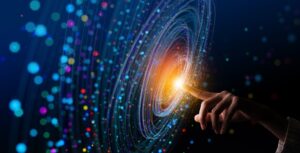For centuries, humans have looked at the stars and speculated about the existence of life beyond our planet, wondering if other planets and solar systems harbor similar conditions that could support life.
Innovations such as telescope optics, high-resolution imaging cameras, and space flights allowed us to extend our understanding of the cosmos. It also enabled us to discover exoplanets – planets that orbit stars outside our solar system.
The first definitive detection of exoplanets was made in January 1992, when astronomers Aleksander Wolszczan and Dale Frail observed timing irregularities in the pulses of radio waves, which indicated the presence of orbiting planets.
Although technology has been instrumental in finding exoplanets, finding exoplanets remains challenging. With the sheer volume of data generated by space missions, satellites, and telescopes, traditional methods for data analysis are often insufficient. The variable sizes, great distances, brightness contrast with host stars, and obscured orbital positions have added to the challenge.
Addressing these complexities, artificial intelligence is revolutionizing the way scientists explore the universe, including the search for exoplanets. Several new studies have emerged, highlighting how advanced AI models can analyze this data with unprecedented accuracy and speed.
Researchers from the University of Georgia applied machine learning to identify planets in formation, a challenging task due to their immense distance and the dense, dust-filled discs that surround them. The team used synthetic telescope data to train the AI models, which were tested and applied to real telescope observations.
The study found that by training AI with simulated data and then using it to analyze real telescope observations, scientists can greatly improve their ability to spot and identify exoplanets. The same team of researchers did another study using machine learning tools to confirm the existence of a previously unknown planet outside of our solar system.
“This is an incredibly exciting proof of concept. We knew from our previous work that we could use machine learning to find known forming exoplanets,” said Cassandra Hall, assistant professor of computational astrophysics and principal investigator of the Exoplanet and Planet Formation Research Group at UGA. “Now, we know for sure that we can use it to make brand new discoveries.”
A team of astrophysicists from the University of Bern (UniBE), the University of Geneva (UNIGE), and the NCCR PlanetS Switzerland, in collaboration with the company Disaitek, leveraged the power of AI to develop a new method to predict the effects of planetary interactions, enabling the discovery of exoplanets.
 The new method is based on training a neural network on star brightness data allowing it to identify subtle patterns caused by these planetary interactions that would be challenging, if not impossible, to detect using traditional techniques such as the transit method. This new approach also accounts for factors that would complicate traditional methods and are often excluded from calculations.
The new method is based on training a neural network on star brightness data allowing it to identify subtle patterns caused by these planetary interactions that would be challenging, if not impossible, to detect using traditional techniques such as the transit method. This new approach also accounts for factors that would complicate traditional methods and are often excluded from calculations.
The researchers believe that while this method is proving to be effective for astronomical observation and detection of exoplanets, it can also be used for observing the Earth for various applications such as identifying illegal dumping.
While scientists have made significant progress in developing and applying tools that aid in discovering worlds beyond our planet, the ultimate goal of the exponent research is to find another Earth-like planet that could potentially harbor life. That is the holy grail of exoplanet research. Life on Earth requires liquid water, so scientists define a star s habitable zone as the region of space where liquid water can exist on a planet s surface.
AI could hold the key to this elusive goal by enhancing the analysis of vast astronomical data sets, enabling the identification of Earth-like exoplanets with greater accuracy and efficiency.
Related Items
How NASA Is Using AI to Develop the Next Generation of Self-Driving Planetary Rovers
An Early Look at How the Metaverse Will Feed AI Models
Unraveling the Fiction and Reality of AI’s Evolution: An Interview with Paul Muzio
#AI/ML/DL #Slider:FrontPage #discovery #exoplanet #machienlearning #planets #science #space [Source: EnterpriseAI]

